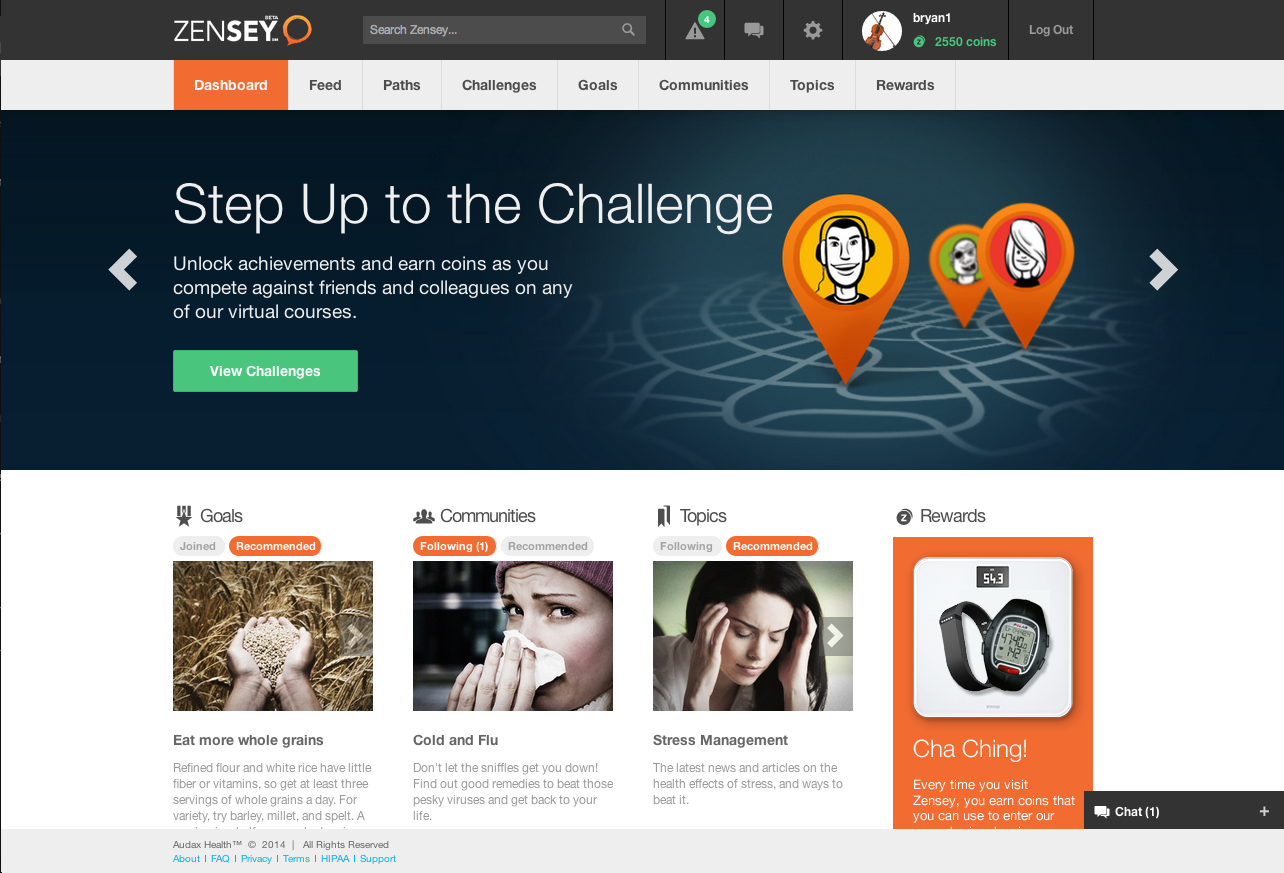DC AngularJS Meetup
presented by
Who are we?
Audax Health is a health software company that focuses on the health and wellness of individuals through our flagship product, Zensey.

Some features we use to engage with individuals:


Who am I?
Bryan Lin
- Software Engineer at Audax Health
- Work primarily in Scala...
- But now am more focused on the AngularJS portion of our stack
- Follow me @hooliganlin
- Challenge me to any Halo game on Xbox Live: BK DERF1
Promises
My Promises to you
You will learn
var avoidCallbackHell = $q.deferred.promisevar chainingPromises = $q.deferred.promisevar createYourOwnPromises = $q.deferred.promise$q.all([avoidCallbackHell, chainingPromises, createYourOwnPromise]).done(function() {// celebrate})
JavaScript and Async
- Asynchronous functionality is achieved through callbacks
var orderCompleted = false; placeOrder(order, function(result) { orderCompleted = result.success; alert('I got my order!', result); }); //do some other things while we are placing an order doingSomethingElse();
- Callbacks are a response to an event that has finished, but it does not return a value.
But wait...
What if I wanted to read a value which the callback function was modifying??
var orderCompleted = false;placeOrder(order, function(result) { orderCompleted = result.success; });//NOO!!!!! orderCompleted is not guaranteed that the order was completed!!shipOrder(order, orderCompleted);
So to "guarantee" the value has been updated...
placeOrder(order, function(results) {//Insert the function to ship the order in the callback...shipOrder(order, results.completed);});
But to add more complexity...
placeOrder(order, function(result) {
authorizeCC(creditCard, function(validCC) {
validateShippingAddr(address, function(validAddress) {
shipProduct(order, function(result) {
//order shipped!! right???
//result.success?? validCC???
});
});
});
});CALLBACK HELL!!!!
Enter in...
Promises
Not this promise:
But this promise:
(note this is part of the Q library by Kowal)
var creditCardValidated = placeOrder(order).then(authorizeCC);var shippingValidated = creditCardValidated.then(validateShipping)Q.all([creditCardValidated, shippingValidated]).done(shipProduct)
Delivery of promise #1:
Avoiding callback hell
What's a Promise?
-
a container that holds or will hold a value
- a time-independent proxy for a remote/external object
- an instance of a class that has utility methods like .then()
- a 'frozen event' you can learn status of at any time
- It's a first-class object so you can:
- Pass it
- Reference it
- Chain it
Reference: http://christianlilley.wordpress.com/2013/09/19/promises-promises-mastering-async-io-in-javascript-with-the-promise-pattern/
Why Promises?
- Easy to read when dealing with async
- You will always be guaranteed a return value/state (fulfilled, unfulfilled, failed)
- You know that value returned within the promise is the value that you expect (even if it's a failure).
- Flexible
- You can chain multiple promises and do something after they have all been fulfilled
var promise = Q.all([promise1, promise2]).then(finalPromise)Angular's promises
//Using the promisefuncThatReturnsAPromise().then(function(success) {console.log(success);}, function(error) {console.log(error)};
//Creating the promisevar promise = function() {var deferred = $q.defer();if (fail)deferred.reject('oh no!!!');elsedeferred.resolve('happy!');return deferred.promise;}
$q
- AngularJS $q is inspired by Kris Kowal's Q.
- Doesn't contain all the features of Q, but the important functionalities
- Integrated with the $rootScope (avoid browser repaint when the model updates)
-
Contains two API:
- Promise API
- Deferred API
Promise API
- .then()
- The action to be executed upon a fulfilled promise
- Actions are callbacks that are resolved, rejected, and notified
- Returns a new promise
var ccPromise = CreditCardService.validateCC(cc).then(function(result) {//resolvedconsole.log('You have a valid credit card', result);},function(error) {//rejectionconsole.log('Dude, something is not right with your card', error);},function(msg) {//notify callbackconsole.log('I have been notified', msg);});
Promise API
- Then() (cont.)
- Because it returns a promise, you can chain them!
var shippingPromise = CreditCardService.validateCC(cc).then(validateShipping).then(calculateTotalPrice).then(shipOrder)
It just makes sense!
Delivery of promise #2:
Chaining promises
Promise API
- catch()
- shorthand for a promise with only a rejection
promise.then(null, rejectionCallback)- finally()
- Think of it as the finally block of a try-catch block. It will always be executed at the end of a statement regardless of a fullfilment or rejection
Defer API
Purposes of the deferred:
- Creates a promise
var deferred = $q.defer(); // promise created internall -
You return the promise, and fulfill it later.
return deferred.promise; - Signals the status of the promise (resolve, reject, notify)
deferred.resolve('successful callback!'); deferred.reject('go home fool, you just got rejected!'); deferred.notify('I just got an alert!');
Defer API
Example above expanded
var doSomethingAsync = function() {var deferred = $q.defer();$timeout(function() {deferred.resolve('Done after 500 milliseconds');}, 500);return deferred.promise;}doSomethingAsync().then(function(resp) {//the message appears after ~500 millisecondsconsole.log(resp);});
Recap on Promises and Deferred
According to Christian Lilley's metaphor: "A Promise is a mailbox"
-
It contains the message you want
- You can pick it up and bring it to whatever context it needs to be in

Reference: http://www.slideshare.net/xmlilley/postal-for-promises-20-min
And the deferred is the mailman

- Assigns you a new mailbox (creating a promise)
- Puts the mail into mailbox (resolve the promise)
- Raises the flag on the box (set the state of the promise)
Reference: http://www.slideshare.net/xmlilley/postal-for-promises-20-min
AngularJS is filled with promises
- $http
- $route
- $timeout
- $resource
Let's create a promise!
Delivery of promise #3:
Creating your own promises
http://bit.ly/1j2a2s4
Before
$q.defer().promise.resolve(nextSpeaker())
$q.defer().promise.resolve(nextSpeaker()) 